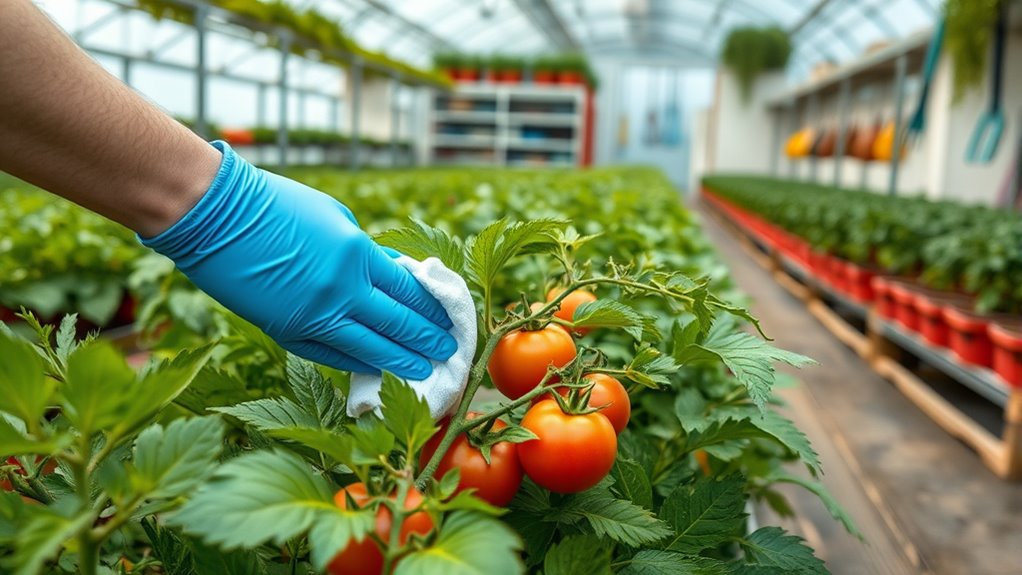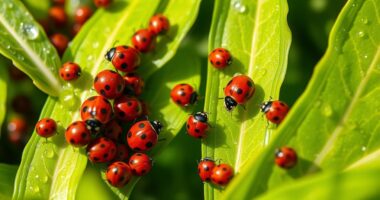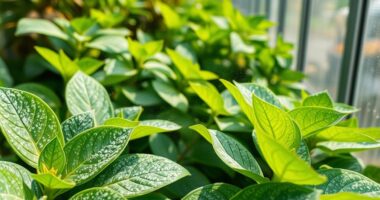To prevent plant diseases in your greenhouse through sanitation, regularly remove fallen leaves, debris, and dead plant material, as these can harbor pests and pathogens. Disinfect your tools, containers, and benches frequently with suitable sanitizers to avoid cross-contamination. Quarantining new plants reduces infection risks, and always inspect for early signs of pests or disease. Maintaining good airflow and proper watering techniques further supports plant health. Keep exploring to discover more expert tips for a healthier greenhouse environment.
Key Takeaways
- Regularly remove fallen leaves, debris, and dead plant material to eliminate disease reservoirs.
- Disinfect tools, containers, and surfaces frequently with appropriate sanitizers.
- Quarantine new plants before introducing them to prevent disease spread.
- Maintain clean benches and workspace to reduce contamination risks.
- Promptly dispose of infected plant material to prevent pathogen transmission.

Maintaining a healthy greenhouse environment is vital to prevent plant diseases from taking hold. One of the most effective ways to do this is by managing garden pests and using proper watering techniques. Pests like aphids, whiteflies, and spider mites can quickly spread diseases and weaken your plants, making them more susceptible to infections. Early detection is key—regularly inspect your plants for signs of pest activity and take prompt action. Introduce natural predators or apply organic insecticides when needed, but always ensure you remove any dead or infested plant material promptly. This reduces the chances of pests establishing a foothold and transmitting diseases.
Regularly inspect and manage pests to prevent disease spread and protect your greenhouse plants.
Your watering techniques also play a pivotal role in maintaining plant health. Overwatering creates a damp environment that favors fungal and bacterial diseases, while underwatering stresses plants, making them vulnerable to pests and pathogens. To avoid these issues, establish a consistent watering schedule based on your plants’ specific needs and the humidity levels inside your greenhouse. Use watering methods that deliver moisture directly to the roots, such as drip irrigation or soaker hoses, instead of overhead watering. This minimizes splashing soil and plant debris, which can carry pathogens onto healthy foliage. When watering, aim for the soil to be moist but not soaked, and allow the surface to dry out between watering sessions. Additionally, high-quality projectors can be used to display helpful guides or reminders for watering schedules and pest management techniques.
Keeping your greenhouse clean is another essential step. Remove fallen leaves, plant debris, and dead plant material regularly. These organic materials can harbor pathogens and pests, acting as reservoirs for future infections. Disinfect tools, containers, and benches frequently using a suitable sanitizer to prevent cross-contamination. Pay special attention to areas around your plants where pests tend to hide or lay eggs, such as the undersides of leaves and in crevices.
Good sanitation also involves managing airflow. Proper ventilation helps reduce humidity levels, discouraging fungal growth and other disease-causing organisms. Use fans or open vents strategically to promote air circulation, but avoid creating drafts that could stress your plants. Always quarantine new plants before introducing them to your greenhouse environment, as they can carry unseen pests or diseases.
Frequently Asked Questions
How Often Should Greenhouse Sanitation Be Performed?
You should perform greenhouse sanitation regularly, ideally on a weekly cleaning schedule. Maintaining a consistent sanitation frequency helps prevent disease buildup and keeps your plants healthy. After each crop cycle, do a thorough cleaning, including tools and surfaces. During the growing season, spot-clean as needed, especially if you notice disease signs. Staying diligent with sanitation ensures a cleaner environment, reducing the risk of plant diseases and promoting ideal growth.
What Are the Best Disinfectants for Greenhouse Tools?
Think of your greenhouse tools as a gateway to healthy plants—using the right disinfectant makes all the difference. For sterilization methods, consider solutions like 70% isopropyl alcohol or commercial disinfectants designed for horticultural use. When selecting a disinfectant, verify it’s effective against common pathogens, eco-friendly, and safe for your tools. Regularly sterilize your tools between uses to keep disease at bay and promote thriving, healthy plants.
Can Natural Remedies Prevent Plant Diseases Effectively?
Natural remedies can help prevent plant diseases if you combine methods like companion planting and soil sterilization. Companion planting boosts plant health and deters pests naturally, while soil sterilization reduces harmful pathogens. You should regularly use these strategies together to strengthen your plants’ defenses. Though natural remedies might not be a foolproof solution, they’re effective when integrated into an all-encompassing sanitation plan, keeping your greenhouse healthier overall.
How Do I Identify Early Signs of Disease?
Think of early disease signs as whispers from your plants. Look for discolored or wilted leaves, spots, or mold. Regular soil testing can reveal nutrient imbalances that make plants vulnerable, while pest monitoring detects unwanted visitors before they cause damage. By staying vigilant and observing subtle changes, you catch problems early, giving your plants the best chance to stay healthy and thrive.
Are There Specific Sanitation Practices for Different Plant Types?
Yes, you should tailor sanitation practices to each plant type for effective disease prevention. For example, wipe down succulents with alcohol-based solutions, clean soil containers thoroughly for root crops, and disinfect pruning tools after trimming. Implement plant-specific sanitation to reduce disease spread and guarantee ideal health. Regularly removing debris, sterilizing equipment, and avoiding cross-contamination are key steps that help protect each plant type in your greenhouse.
Conclusion
By keeping your greenhouse clean, you’re like a vigilant gardener shielding delicate plants from unseen threats. I once saw a fellow gardener wipe down tools after every use, and their plants thrived—no disease outbreaks. Remember, sanitation isn’t just a chore; it’s the armor that protects your green oasis. With consistent effort, you’ll create a healthy environment where your plants can flourish and grow strong, just like a well-guarded fortress of vibrant life.








